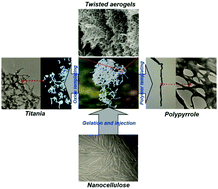Aerogel templating on functionalized fibers of nanocellulose networks†
Abstract
We present novel spaghetti-like gel fibers of gelatin-functionalized cellulose nanocrystals (gCNCs) and aerogel templating of semiconductors on the gCNC scaffolds. An injection method is first used to make CNC aerogel fibers by crosslinking with gelatin (GE). The gelation of the injectable fibers can be conducted by manipulating interactions between CNCs and GE to preserve the chiral nematic order. The gCNC fibers are then used as templates to make porous TiO2/gCNC aerogel composites with structural organization imparted by the chiral arrangement and hierarchical organization of the gCNC fibers. The uniqueness of this templating concept lies in its ability to truly replicate spindle-shaped features of CNCs in freestanding TiO2 nanofibrillar aerogels. The affinity of functional groups of gelatin on the CNC aerogels with metal-based precursors causes the attachment of TiO2 nanoparticles around cellulose nanorods to form core–shell-like aerogel composites. The uniform integration of these components leads to the retention of TiO2 aerogel fibers after thermal removal of the gCNC template. To further demonstrate the use of gCNC fibers for templating, they are used to fabricate polypyrrole composites that retain the chiral structure of the aerogel. These new templated fibers are promising materials for supercapacitor electrodes, sensors, catalysts, and dye-sensitized solar cells. The results described here demonstrate a new and generalizable method to construct mesoporous materials with an open-network structure through helicoidal aerogel templating at the nanoscale.

- This article is part of the themed collection: Industry R&D collection


 Please wait while we load your content...
Please wait while we load your content...